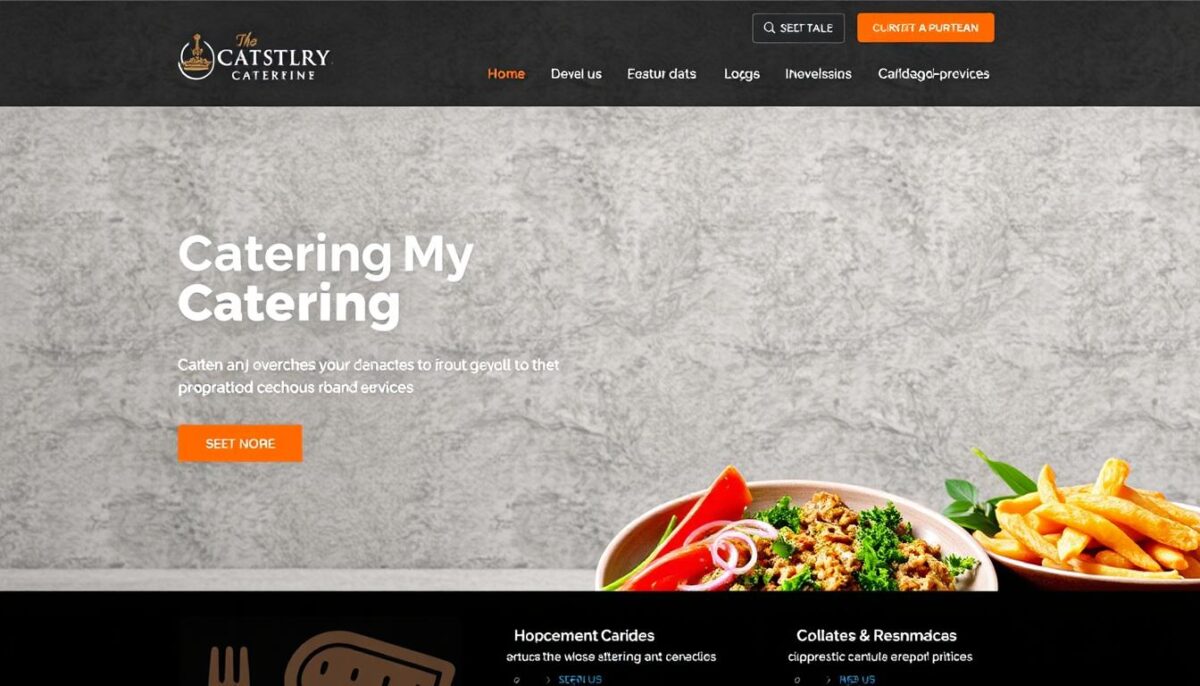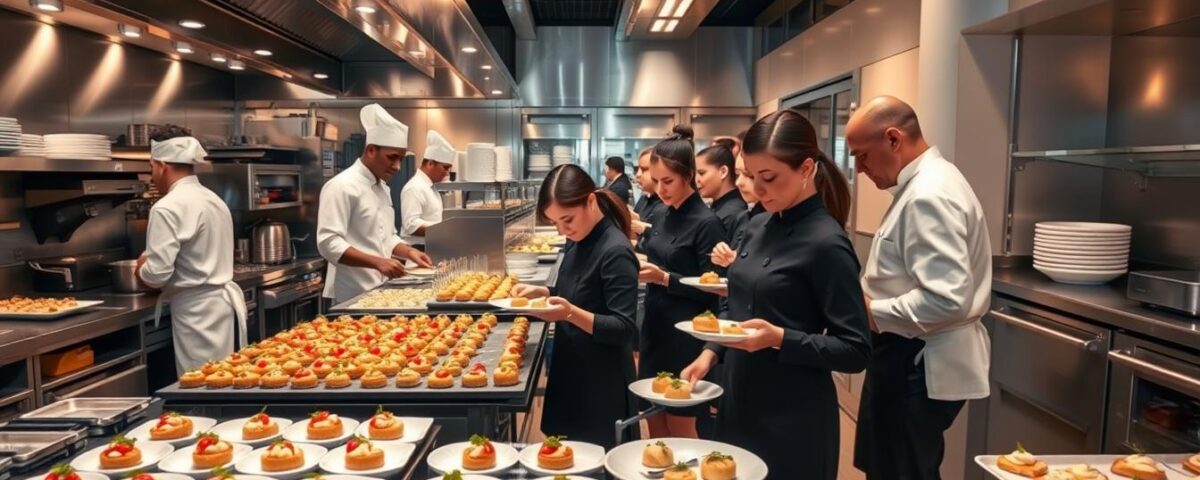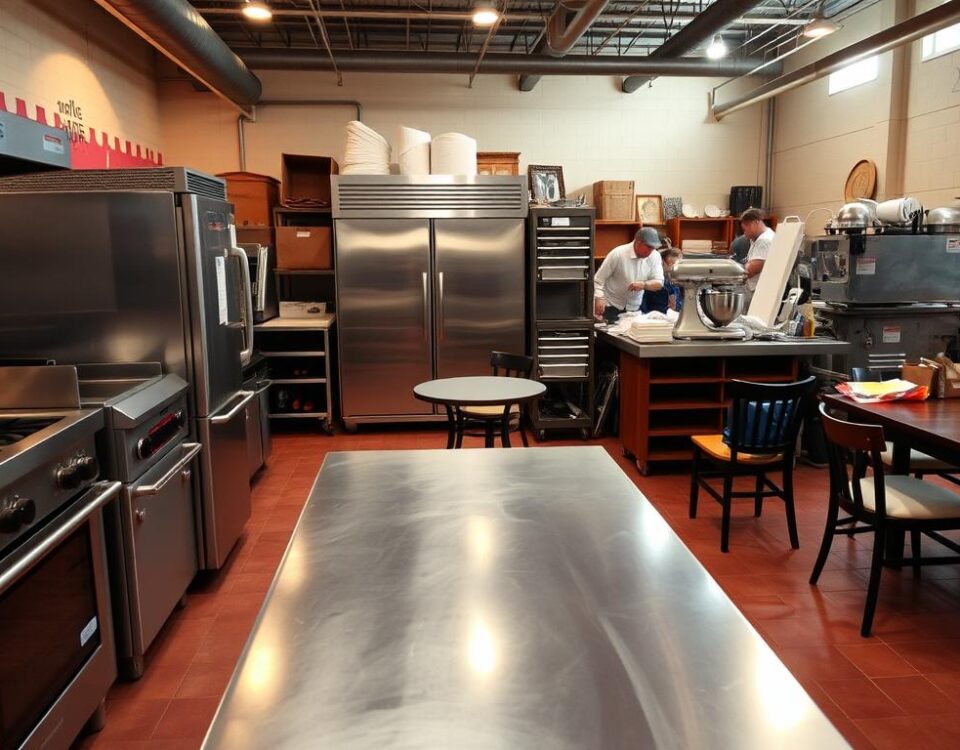
Top Chef Certification Courses to Boost Your Culinary Credibility
June 27, 2025
Best Chef Knife for 2025 Ranked by Professional Kitchens
June 28, 2025Imagine turning your passion for food into a thriving venture, with the freedom to create menus that delight and events that impress. For many culinary entrepreneurs, this dream becomes a reality through catering business. The catering industry has seen significant growth, with spending in the UK doubling from £44 billion in 1997 to over £89 billion in 2017, indicating a strong market potential.
Starting a catering company can be a rewarding venture with relatively lower initial costs compared to opening a restaurant. As a professional chef or food enthusiast, you can capitalize on this trend by establishing a profitable business that stands out in a competitive market.
With the right guidance, you can navigate the process of launching and growing a successful catering business in 2025. What if you could turn your culinary skills into a lucrative business that brings joy to your clients and satisfaction to your customers?
Key Takeaways
- Understand the essential steps to launch a catering business from scratch.
- Learn how to create a comprehensive business plan that drives success.
- Discover effective marketing strategies to attract and retain clients.
- Explore ways to scale your catering operations for long-term growth.
- Identify your niche and develop a unique selling proposition.
Understanding the Catering Industry Landscape in 2025
The year 2025 brings new opportunities and challenges to the catering industry, shaped by post-pandemic consumer expectations and technological advancements. As the industry continues to grow, understanding its current landscape is essential for any new caterer looking to succeed.
Current Market Trends and Opportunities
The catering market is evolving with increased demand for specialized dietary options, sustainable practices, and unique culinary experiences. According to market research, approximately 63% of US-based caterers report serving social/consumer events, 48% report serving corporate events, and 28-31% report serving weddings. This data highlights the diverse opportunities available in the catering industry.
- The demand for specialized dietary options is on the rise, driven by consumers with specific dietary needs.
- Sustainable practices are becoming increasingly important, with consumers preferring caterers who use locally sourced and environmentally friendly ingredients.
- Unique culinary experiences are also in high demand, with consumers looking for caterers who can provide innovative and memorable dining experiences.
Potential Challenges for New Caterers
Despite the opportunities, new caterers face several challenges, including seasonal fluctuations in demand, increasing food costs, labor shortages, and navigating complex health regulations. Successful caterers are adapting to these challenges by leveraging technology to streamline operations and enhance customer experiences.
| Challenge | Description | Adaptation Strategy |
|---|---|---|
| Seasonal Fluctuations | Demand varies by season, affecting business consistency. | Diversify services to cater to different events and seasons. |
| Increasing Food Costs | Rising costs of ingredients impact profit margins. | Negotiate with suppliers, consider local and seasonal ingredients. |
| Labor Shortages | Difficulty in finding and retaining skilled staff. | Invest in staff training, consider flexible staffing options. |
Finding Your Catering Niche and Specialization
Your catering business’s niche is the foundation upon which you’ll build your brand’s identity. When you focus on a specific area, you face less competition from larger, more generalized caterers, making it easier to establish a loyal client base through word-of-mouth marketing.
Identifying Profitable Catering Niches
To give your business a competitive edge, it’s essential to identify profitable catering niches that align with your culinary skills, passion, and local market demands. Specializing in a specific type of cuisine or event can significantly reduce competition and establish your catering business as the go-to option in that niche.
Analyzing Your Local Competition
Conducting thorough market research is crucial to analyze local competitors, including their menus, pricing strategies, target demographics, and company size. By creating a spreadsheet with competitor information, you can identify gaps in the market and opportunities for differentiation that you can leverage for your catering business.
Defining Your Unique Selling Proposition
Defining your unique selling proposition is vital for standing out in a crowded market. Whether it’s specialized cuisine, exceptional presentation, sustainable practices, or outstanding service, your specialization should reflect both your culinary strengths and your target market’s preferences. I’ll share strategies for testing your concept with potential customers through sampling events, surveys, and focus groups to validate your niche before fully committing to it.
How to Start a Catering Business: Essential First Steps
When starting a catering business, it’s essential to lay a solid groundwork. This involves several key steps that will set your business up for success.
Researching Your Target Market
Researching your target market is crucial to understand who your ideal clients are, what events they host, and their culinary preferences. This information helps tailor your offerings to meet their needs, increasing your chances of success. By identifying your target audience, you can create targeted marketing campaigns and develop menus that appeal to them.
Creating a Solid Business Plan
A comprehensive business plan is vital for your catering business. It should include an executive summary, company description, market analysis, organization structure, service offerings, marketing strategy, and financial projections. This plan will serve as a roadmap, guiding your decisions and helping you stay on track.
Calculating Startup Costs and Securing Financing
Startup costs for a catering business can range from $10,000 to $50,000, depending on equipment, transportation, and marketing needs. Your initial budget should cover operating expenses for at least 12 months without relying on revenue. You can explore financing options such as small business loans, personal savings, investors, partnerships, and grants to secure the necessary funds.
| Startup Cost Category | Estimated Cost |
|---|---|
| Equipment | $5,000 – $20,000 |
| Transportation | $2,000 – $10,000 |
| Marketing | $3,000 – $10,000 |
| Total | $10,000 – $50,000 |

Legal Requirements for Your Catering Business
Complying with legal requirements is a fundamental aspect of running a catering business, and I’m here to guide you through the process. As you establish your venture, you’ll need to navigate various licenses, permits, and insurance coverage to ensure you’re operating legally and protecting your business.
Business Licenses and Permits
Every catering company needs a general business license issued by your state, municipality, city, or county. This license serves as your basic authorization to operate. Additionally, you may need a zoning permit, depending on where you’ll locate your cooking facilities, and health permits, depending on where you’ll be preparing food and whether you’ll be transporting it.
Food Safety Certifications
Food safety certifications are critical for your small business. You’ll need to understand local health department regulations and obtain proper food handler permits for yourself and your staff. This not only ensures compliance with the law but also builds trust with your clients.
Insurance Coverage for Caterers
Insurance is not optional for caterers. You’ll need to consider general liability insurance for accidents and food-related illness claims, commercial auto insurance for delivery vehicles, and property insurance for equipment. Understanding these requirements will help you protect your business and assets.
Setting Up Your Catering Kitchen
Setting up your catering kitchen requires careful planning and consideration of several key factors. The location and layout of your kitchen will significantly impact your ability to operate efficiently and comply with local regulations.
Home-Based vs. Commercial Kitchen Options
When deciding between a home-based and commercial kitchen, consider local laws and your business scale. Some states have restrictions on using home kitchens for commercial food preparation, known as “cottage food laws.” If you need a commercial space, options include renting shared kitchen spaces or commissary kitchens.
Essential Equipment and Supplies
Your catering kitchen will need essential equipment such as cooking appliances, food preparation tools, and serving equipment. For startups, consider catering equipment that is versatile and scalable.

Food Storage and Transportation Solutions
Proper food storage and transportation are critical for maintaining food safety. You’ll need refrigeration units, dry storage solutions, and insulated carriers to keep food at the right temperature during transport.
Image of food storage and transportation equipment
By carefully planning your kitchen setup and investing in the right equipment, you’ll be well on your way to running a successful catering business.
Developing Your Catering Menu
Your catering menu is the backbone of your business, requiring careful planning and creativity. It’s essential to strike a balance between offering a variety of options that appeal to different customers and maintaining a manageable menu for your kitchen.
Creating Signature Dishes
Developing catering signature dishes helps differentiate your business and gives customers a reason to choose you. These dishes should reflect your culinary strengths and brand identity.
Pricing Your Menu Profitably
Pricing your menu involves calculating food costs, labor, overhead, and profit margins. The standard formula for food pricing in catering typically involves multiplying costs by 2.5-3.5, depending on your market positioning.
Accommodating Dietary Restrictions and Preferences
Accommodating dietary restrictions is crucial. Develop flexible menu options for common needs like vegetarian, vegan, gluten-free, and allergen-free dishes to cater to a wide range of customers.
| Menu Item | Food Costs | Pricing |
|---|---|---|
| Vegan Dish | $5 | $15-$17.50 |
| Gluten-Free Dish | $6 | $18-$21 |
Building Your Catering Team
As your catering business expands, assembling a skilled team becomes crucial for maintaining quality and driving growth. A well-structured team enables you to handle larger events, improve service quality, and ultimately scale your business.
Essential Roles
To build a comprehensive team, you’ll need to fill several key positions. These typically include chefs or cooks, preparation staff, servers, event coordinators, and potentially drivers, depending on your business model. Identifying the right roles to fill is crucial for the smooth operation of your catering company.
Hiring and Training
Finding reliable staff is vital, and you can achieve this by tapping into culinary schools, hospitality programs, and industry networks. Once you’ve hired your staff, training is critical to maintain consistent quality and service standards. Developing effective training programs for both kitchen and service staff will ensure that your team is well-equipped to handle various events and customer needs.
Managing Part-Time Staff
Managing a part-time workforce in the catering industry comes with unique challenges, such as irregular schedules and event-based work patterns. To keep your team engaged and reliable, you’ll need to implement effective scheduling, communication, and retention strategies.
| Team Member | Key Responsibilities |
|---|---|
| Chefs/Cooks | Food preparation, menu execution |
| Event Coordinators | Event planning, client communication |
| Servers | Food service, customer interaction |

Marketing Your Catering Business Effectively
In the world of catering, marketing is not just about promoting your services; it’s about building a brand that resonates with your target audience. To achieve this, you need to implement a multi-faceted marketing strategy that includes online presence, social media, and networking.
Building a Strong Online Presence
Building a strong online presence starts with a professional catering business website design that showcases your menu, services, and beautiful food photography. This will make potential customers hungry just looking at it.

Leveraging Social Media for Food Businesses
Social media is particularly powerful for food businesses. Creating engaging content for platforms like Instagram, Facebook, and Pinterest that showcase your culinary creations can help attract new customers.
Networking and Partnership Strategies
Networking with complementary businesses like event planners, wedding venues, and corporate event coordinators can create valuable referral partnerships. These partnerships can generate steady business for your catering company.
By implementing these strategies, you can effectively market your catering business and attract new customers.
Managing Client Relationships and Events
As a caterer, managing client relationships and events efficiently is vital for long-term success. This involves creating a seamless booking process, thorough pre-event planning, and effective post-event follow-up.
Creating Seamless Booking Processes
To make it easy for clients to work with you, it’s essential to streamline consultations, tastings, contracts, and payment processes. This can be achieved by implementing a user-friendly online booking system and clear communication channels.
Pre-Event Planning and Coordination
Pre-event planning is critical for flawless execution. This includes conducting site visits to identify potential challenges, creating detailed timelines, and coordinating with clients, venues, and your team. A comprehensive checklist can help ensure that nothing falls through the cracks.
Post-Event Follow-Up and Feedback
Post-event follow-up distinguishes professional caterers from amateurs. Sending thank-you notes, requesting feedback, and soliciting reviews can strengthen client relationships. Collecting and implementing customer feedback helps continuously improve your service and shows clients you value their input.
| Event Stage | Key Activities | Benefits |
|---|---|---|
| Pre-Event | Site visits, timeline creation, team coordination | Flawless execution, reduced stress |
| During Event | Setup, service, breakdown management | Smooth operations, client satisfaction |
| Post-Event | Follow-up, feedback collection, review solicitation | Strengthened client relationships, service improvement |

By implementing these strategies, caterers can create exceptional customer experiences, build strong client relationships, and drive business growth.
Financial Management for Catering Success
Effective financial management is crucial for the success of any catering business. As a caterer, you’re not only responsible for creating delicious dishes, but also for managing the financial aspects of your company.
Setting Up Proper Bookkeeping Systems
A well-organized bookkeeping system is essential for tracking every dollar coming in and going out of your business. I recommend setting up accounting software specifically designed for small food businesses to monitor ingredient costs, labor expenses, and profitability per event.
Managing Cash Flow and Expenses
Managing cash flow is vital for catering businesses with irregular income patterns. To ensure you can cover expenses during slower periods, implement cash flow management strategies, such as maintaining a cash reserve or adjusting your pricing structure.
Pricing Strategies for Profitability
Understanding your true costs is essential for profitability. Calculate not just food costs, but also labor, transportation, equipment depreciation, and overhead expenses. Consider tiered pricing options, package deals, and premium add-on services to ensure profitability while remaining competitive.
| Expense Category | Average Cost | Percentage of Total Expenses |
|---|---|---|
| Food Costs | $5,000 | 40% |
| Labor Expenses | $3,000 | 25% |
| Transportation Costs | $1,000 | 8% |
Scaling Your Catering Business
The decision to scale your catering business should be based on careful consideration of several key factors. As your business grows, it’s crucial to recognize when it’s time to expand your operations to meet increasing demand.
Signs You’re Ready to Expand
Five key benchmarks indicate it’s time to expand your catering services: a strong industry reputation, financial stability, a steady flow of customers, repeat clients, and a solid marketing strategy. If you consistently book events months in advance or have a waitlist, it’s a sign that you’re ready to scale.
Growth Strategies for Caterers
To scale your catering business, consider expanding your service area, increasing event capacity, or targeting different market segments. Moving from a home-based operation to a commercial kitchen can significantly enhance your ability to handle larger events and multiple bookings simultaneously.
Adding New Revenue Streams
Diversifying your business with new revenue streams can help sustain growth. Consider offering meal prep services, cooking classes, or product lines like sauces and spice blends. These additional services can attract new customers and increase average revenue per user.
Conclusion
By following the steps outlined in this guide, you’ll be well on your way to building a reputable catering company that delivers exceptional services to your clients. To start a catering business, you’ll need to identify your niche, create a comprehensive business plan, and set up an efficient kitchen. Remember, success in the catering industry doesn’t happen overnight; it requires patience, persistence, and a commitment to quality.
As you begin your journey, focus on building strong relationships with your customers and continually adapt to the evolving needs of your business. With the right preparation and dedication, your catering business can thrive in this competitive industry. You’ll need to invest in versatile equipment and develop strategies for managing events effectively. By doing so, you’ll be well on your way to establishing a successful catering company that stands out in the market.
FAQ
What are the most important licenses and permits required for a catering business?
The licenses and permits required vary by location, but typically include a food service permit, business license, and health department permit. I recommend checking with local authorities to determine the specific requirements for my area.
How do I determine the right pricing for my catering services?
To determine pricing, I consider food costs, labor expenses, equipment rental fees, and other overhead costs. I also research my competitors and target market to ensure my prices are competitive and aligned with customer expectations.
What type of insurance coverage do I need for my catering business?
As a caterer, I need insurance coverage that includes general liability, product liability, and possibly equipment insurance. I also consider workers’ compensation insurance if I have employees. It’s essential to consult with an insurance professional to determine the best coverage options for my business.
How can I effectively market my catering business to potential clients?
To market my catering business, I focus on building a strong online presence through my website and social media channels. I also leverage networking opportunities, such as wedding expos and food festivals, to showcase my services and connect with potential clients.
What are some strategies for managing a successful catering event?
To manage a successful catering event, I prioritize pre-event planning and coordination, ensuring that I have a clear understanding of the client’s needs and expectations. I also focus on providing exceptional customer service and maintaining open communication with my clients throughout the event.
How can I accommodate diverse dietary needs and preferences in my catering menu?
To accommodate diverse dietary needs, I offer a variety of menu options that cater to different dietary restrictions, such as gluten-free, vegan, and vegetarian. I also work closely with clients to understand their specific needs and preferences, ensuring that I provide a customized menu that meets their expectations.
What are the key elements of a successful catering business plan?
A successful catering business plan includes a clear definition of my target market, a detailed marketing strategy, and a comprehensive financial plan. I also outline my menu offerings, pricing structure, and operational logistics to ensure a solid foundation for my business.
How can I scale my catering business for growth and expansion?
To scale my catering business, I focus on identifying signs of readiness for growth, such as increased demand or new business opportunities. I then develop strategies for expansion, including adding new revenue streams, investing in marketing and advertising, and potentially hiring additional staff to support increased demand.



